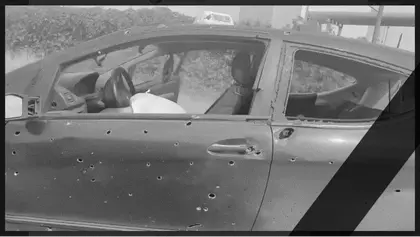According to Ukrainian state nuclear power operator Energoatom on Aug. 22, shelling of a taxi in the city of Enerhodar resulted in the death an employee of the Zaporizhzhia nuclear power plant.
Vladyslav Mitin, a mechanic at the thermal automation and measurement shop, was initially injured in the attack. He was subsequently treated in hospital but died in intensive care a few hours later from severe injuries.
JOIN US ON TELEGRAM
Follow our coverage of the war on the @Kyivpost_official.
On Aug. 22, the occupiers brought two armored personnel carriers and six special trucks to the repair zone of the Zaporizhzhia plant.
In total, more than 40 units of military equipment are now stationed on the plant’s territory. These include (among others) 16 military vehicles near the first power unit and seven near the second.
The Zaporizhzhia plant continues to operate at risk of radiation and fire safety standards being compromised. Regular shelling of the plant by Russian troops with anti-aircraft missiles poses a serious and on-going risk to the safe operation of the site.
On Aug. 20, the U.K.’s Chair of the Defense Select Committee, Tobias Ellwood, said that in the event of a radiation leak due to a Russian attack on the Zaporizhzhia plant, NATO should use Article 5 of its charter.
Member of the House of Representatives of the U.S. Congress, Adam Kinzinger, strongly supported the statement of the British parliamentarian. “Indeed, it’s not even up for debate. Any radiation leak will kill people in NATO countries. This automatically triggers Article 5,” Kinzinger wrote.

EU Transfers €1.5 Bln Raised From Russian Assets for Ukraine
According to Article 5 of the charter, in the event of an armed attack on any NATO country, all other members of the Alliance will consider this act an attack against all of them.
There have been a number of attacks on the Zaporizhzhia plant in August, which are compounding safety risks:
- On Aug. 5, following an assault by the Russian military, the emergency protection of one of the power units was activated. This resulted in one of the three operating power units being disconnected. The nitrogen-oxygen station and the combined auxiliary building were seriously damaged during the shelling. There are still risks of hydrogen leakage and sputtering of radioactive substances, and the risk of fire is high;
- On Aug. 6, shelling by the invaders damaged three radiation monitoring sensors around the site;
- On Aug. 11, the occupiers attacked the fire department, located outside the territory of the plant, which was designed to protect it against the risk of fire;
- On Aug. 13, the 750 kV open switchgear (VRP-750) was damaged;
- On Aug. 20, shelling damaged one of the transitional galleries through which personnel enter the power units, with windows being broken.
The Ukrainian staff of the station continue to work and make every effort to ensure nuclear and radiation safety and eliminate the consequences of damage.
The plant is still occupied and controlled by the Russian military. Given that it is impossible to predict the actions of invaders, the threat to the station’s physical security continues.
Currently, the plant continues to operate and produce electricity for the needs of the domestic power system.
You can also highlight the text and press Ctrl + Enter






